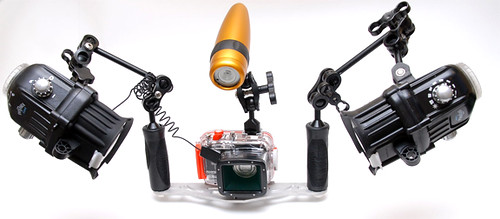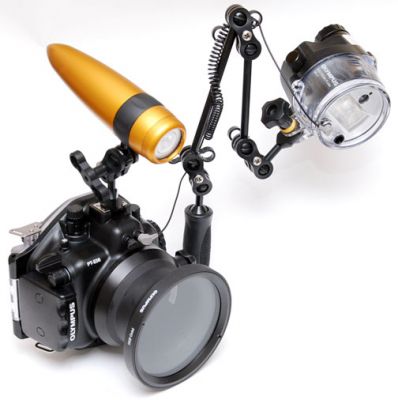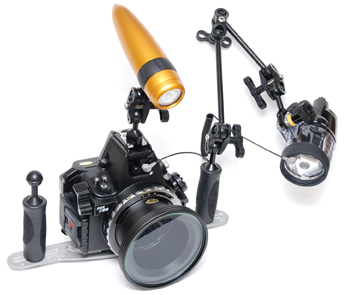Test Dive: Fuji F200EXR & Fantasea Remora Strobe
 Test shooting the F200EXR in Fuji's WP-FXF-200 housing and two of the new Fantasea Remora strobes has led me to believe that it's a good uw photo rig, not perfect, but quite capable of wonderful shots at a reasonable price - if you shoot within it's limitations.
Test shooting the F200EXR in Fuji's WP-FXF-200 housing and two of the new Fantasea Remora strobes has led me to believe that it's a good uw photo rig, not perfect, but quite capable of wonderful shots at a reasonable price - if you shoot within it's limitations. The Fuji F200EXR camera is Fuji's foray to using innovative Extended Definition and Range in a point and shoot camera. But underwater I've found little value to this technology, mainly because they've crippled many of the controls to make them simpler for the "average" user. This leads to the camera getting confused. For instance set to EXR mode, you cannot fire the strobe in DR D-Range Priority sub mode. You are limited to Resolution Priority, fine, but then it uses too slow a shutter speed. Setting it on EXR Auto picks the low-light, Hi-ISO SN sub-mode, as it thinks (rightly so) you are shooting in low light. Which is sort of ok for available light shots, but gets grainy and worthless with an external strobe.
But not all is lost. There is a manual mode that works pretty well. You can access the extended range if you set the ISO to 200 or above. Then you get extra Dynamic Range, which is cool. But again, under the "what was Japan thinking" they crippled the manual mode, you can select shutter speeds, but are limited to f/3 or f/9 at wide angle, (and higher f/stops at greater telephoto extension of the lens)! Ok, so set it to f/9 and use the shutter speeds and strobes to control your shots, it's not a bad situation, just annoying. There is also a "P" mode that has an "Auto" setting, a not-so-good idea underwater (as it is on nearly all cameras) and an Aperature priority mode. which is ok, except that once again it picks too slow a shutter speed uw when you use a flash. There is a dedicated underwater scene available, and it did ok on available light shots. It might do better in bluewater (filtering cyan cast) if you weren't using an external flash, but I couldn't test that.
You can generate up to 12MB images, depending on which mode you are using. I wish the camera manufacturers would bring back RAW output, it costs them nothing to do so, the F200 does a nice job with JPEGS however.
The WP-FXF-200 is a decent, $170 housing, small and with all camera controls available. I did remove the large flash diffuser to attach the sync cord, it didn't work well when just put on the front of it. I taped off he inside of the housing to remove any light leaks from the internal flash. The housing is depth rated to 40 meters (132'), and I tested it to 95 feet in cold water without any incident. About the only problem I had was hitting the mode dial on the back of the housing with my thumb.
Several really good good features make this camera very responsive and easy to use underwater.
One is "Dual IS Mode", it's built-in image stabilization mode. I found this worked pretty well, steadying some shots at the lower shutter speeds it selects on some of the auto modes, but again it only seems to kick in when you zoom. The second is sort of a sleeper; located under Power Management is a "Quick AF" mode, speeding up auto focus and supposedly using more power. In my test shooting, it made the F200 respond much faster, with very little shutter lag, a bane to most P&S photographers. BTW, "Face Detection" also works on fishes - kind of cool, moving the auto focus around as the fish moves.
Speaking of power management, I found on an hour or more of fairly steady shooting that I only used 1/4 of the lithion battery, much better than older Fuji models. Shooting movies will use it much faster.
The F200 focuses quite well in low-light, and if you don't mind grainier shots, can take good available light photos and hold both the highs and lows in a (flatter looking) shot using DR. A focus light makes it work that much faster.
Another high point of the camera is it's built in macro mode, simply awesome, most of the time I can touch the housing to the subject and it is exceedingly sharp. Coupled with Fuji's rich, saturated colors from it's great sensor, I personally think it's amongst the best P&S cameras, especially for macro, even without additional lenses. You just need to be aware of it's design limitations, they may be deal-breakers for you.
Fantasea Line has developed a range of available wide angle and mcro lenses, red filters and adapters to fit the Fuji housing. Their Big Eye FXF-100/200 restores the refraction you loose underwater, not truly super wide, but still gives a very nice result. They will have an adapter to take 67mm lenses as well, which opens a whole range of accessory lenses from a variety of manufacturers.
Settings I gravitated to are using Manual mode, f/9, ISO 200 with a shutter speed of 1/60th for W/A and moving the shutter speed way up to 1/1000th and ISO 100-200 for macro, for the sharpest shots.
The Remora is a new product for Fantasea and represents their first true amphibious strobe. It has a guide number (power) of 18, which seems to be true in my experience. The recycle time is quite fast and the strobe features a 10-100% varible output, usually found on more expensive strobes. Although it uses nearly the same flash tube as the UltraMax UDXS strobe, they have a better lens and diffuser that gives off a nice quality of light. The color temp is daylight balanced.
About my only two complains, ok 3, are:
- No sealed battery compartment, if it floods, it's toast. Most other competing strobes have a separate compartment. It does have a curved back that leads water away from the opening very well. They held this product off the market for quite some time to improve the seals, but even my prototypes worked fine down to 90'.
- A rectangular flash output, you have to watch which way you spin them, I use mine upside down/angled pretty often. This gets a bit annoying.
- Controls on the side. Again depending on their orientation you have to really bring the whole rig down to see the adjustment. You can turn them without looking, but a couple of times I adjusted them the wrong way.
With use, you'd get used to some of these quirks.
All that said, it is a decent strobe for the money, and you can mount a focus light for targeting it. It needs a sync cord, and my testing shows that for best operation with two you should use two sync cords.
Street price of the Remora is about $200, plus a $30 cord. The next strobe up from it price-wise, is the Sea & Sea YS27DX which has a GN of 20, a much wider beam and 8 steps of adjustment. It is smaller physically and has a better build quality and sealed battery compartment. I'd definitely pick this strobe if you can afford it's $350 cost. But for it's value the Remora looks like it has a nice niche.
I used a prototype of the new Optical Ocean Sales Flat Tray (available in early September), along with handles and arms to hold the strobes. It makes for nice control of the rig and the balance overall was just slightly negative.
DP Review's extensive review of the Fuji F-200FXF is pretty fair I think, and has great in-depth information on all the modes.
The below shots are straight from the camera, no manipulations.
















